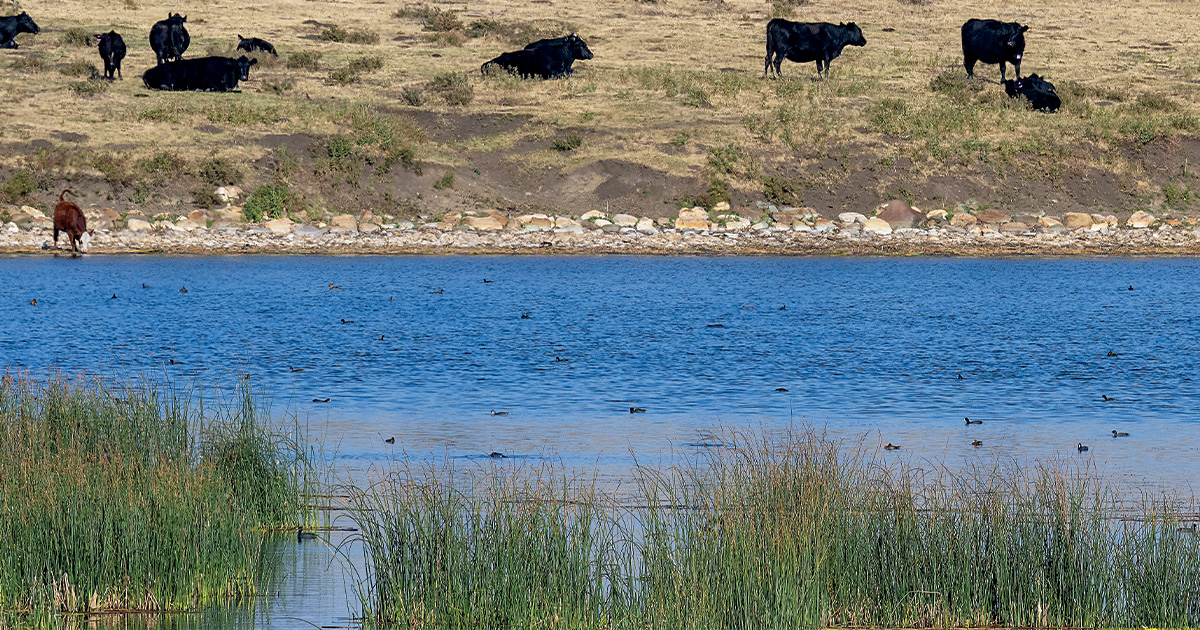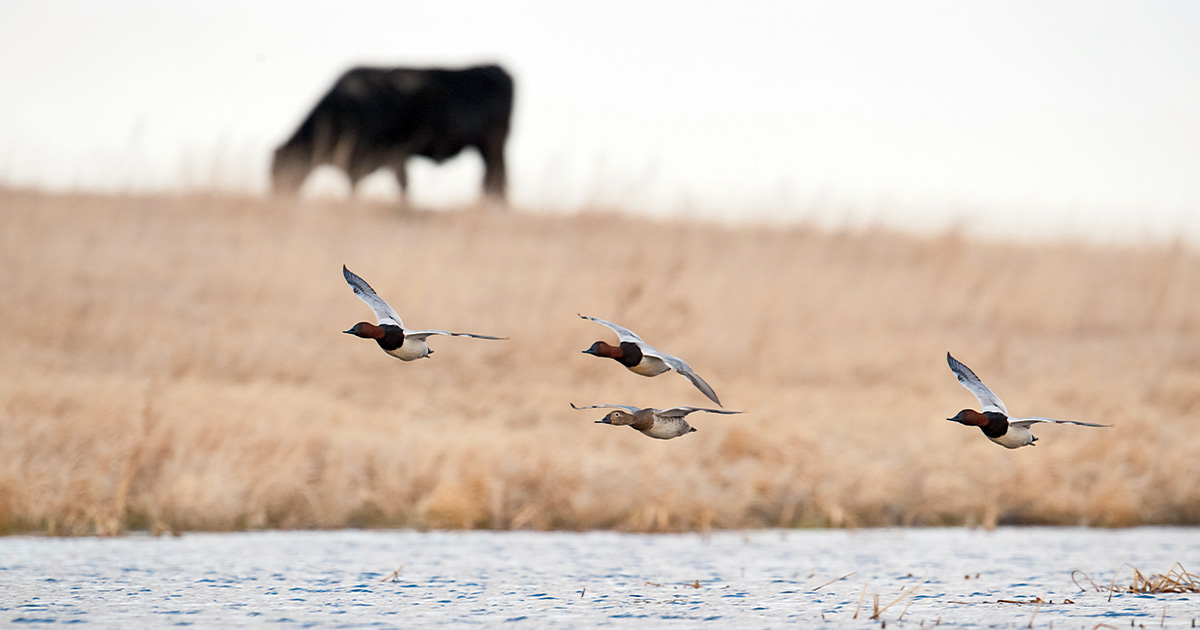Conservation: The Cattle Connection
Livestock producers are among DU's most important conservation partners
Livestock producers are among DU's most important conservation partners
By Jennifer Boudart

Cattle and nesting ducks depend on healthy wetlands and abundant grasslands. DU and its partners are working with ranchers to conserve crucial waterfowl habitat on grazing lands while also improving resiliency and profitability of cattle operations.
Why are ducks and cattle so often found side by side? Billy Gascoigne says it’s because the means for production of cattle and ducks are essentially the same. “To grow a healthy cow, you need healthy grasslands and clean water. In the same way, ducks need healthy grasslands to nest and rear young, and wetlands where ducklings can grow and take refuge.”
This important connection between cattle and ducks helps inform Gascoigne’s work as DU’s director of agriculture and strategic partnerships. He is tasked with increasing DU’s capacity to deliver conservation on working lands across the United States, but primarily in the Prairie Pothole Region (PPR). Up to 70 percent of North America’s waterfowl nest in this region, where the majority of land is privately owned and managed for some form of agriculture. “Our core priority areas happen to be working grasslands and those intermixed wetlands,” notes Gascoigne, “so it behooves us to work with ranchers to think about ways to help them on their path of continuous improvement.”
DU has developed a robust soil-health program on the prairies that focuses in part on helping ranchers adopt regenerative agricultural practices that increase the resilience and profitability of their operations while optimizing habitat for waterfowl and other wildlife. These practices include converting marginal croplands back to native perennial grasslands, restoring wetlands and water resources for cattle, and implementing rotational grazing plans. “Through this program, DU is able to give ranchers the tools they need to improve forage availability, productivity, and overall animal health, which in the ranching world equates to more money in your pocket,” Gascoigne explains.
Participating landowners receive technical assistance that ranges from help with completing necessary contract paperwork to developing grazing management plans, installing infrastructure, and monitoring changes in soil health and other metrics. DU also provides cost-sharing to offset the up-front expenses required in the switch to regenerative agriculture. This hands-on involvement by DU and its partners is key to helping ranchers feel more comfortable changing practices they may have used for generations, Gascoigne says.
The US Fish and Wildlife Service (USFWS) and USDA Natural Resources Conservation Service (NRCS) work closely with DU and cattle ranchers through a variety of Farm Bill conservation programs. Financial support also comes from private donors and corporate partners, including First National Bank of Omaha; UMB Financial Corporation; Elanco Animal Health; Starion Bank; Millborn Seeds, Inc.; Tractor Supply Company; Valmont Industries; and Certified Angus Beef, among others.
Gascoigne points out that DU also supports producers by fostering relationships with others in the livestock industry who don’t necessarily improve producers’ grasslands directly but do improve their profitability, which is core to long-term protection of the resource. “For example, DU is part of the US Roundtable for Sustainable Beef and Farm Journal’s Trust In Beef, which are both looking to bring added market value for beef raised in a way that sustains or enhances the habitats we also care about,” he notes. And it is why DU is excited to partner with Certified Angus Beef (CAB), the world’s biggest premium beef brand.
In 2021, DU and CAB launched a three-year collaboration called the Working Grasslands Conservation Initiative. The two organizations made a combined initial investment of $500,000 and have subsequently secured an additional $2.5 million in grant funds for projects across North and South Dakota. The initiative engages ranchers in voluntary cost-sharing programs focused on preserving and restoring grasslands that are beneficial to cattle ranching, duck production, and overall ecosystem health. DU is providing technical expertise, and CAB is communicating project results up and down its supply chain.

DU's grazing programs started on the prairies and are now expanding into other areas of the country where important waterfowl habitats and ranching operations overlap.
“This collaboration with DU is a perfect fit for us because it allows us to participate in programs that continue to expand and express our value of environmental stewardship as part of cattle care,” says Bruce Cobb, executive vice president of production for CAB. “We’ve had a mindset of let’s leave it better than we found it for generations in the ranching industry. Now we have an opportunity to really share that message with consumers because they have a growing interest in it too.”
Roughly 250 landowners participated during the partnership’s first year, and feedback from ranchers has been very positive. “There’s a high level of gratitude around learning about how to move forward and get better, to prepare for the next generation by making a difference in production practices today,” Cobb says. Moreover, DU’s first-year analysis shows positive results not only for acres conserved but for ecosystem services such as floodwater storage, biodiversity, carbon sequestration, and reduced soil erosion and chemical runoff.
Another innovative partnership with the ranching community is the 2020 Memorandum of Understanding (MOU) DU signed with the National Cattlemen’s Beef Association, joining the Public Lands Council, Safari Club International, and USFWS as signatories. The MOU outlines the groups’ shared commitment to sustainable use of public lands and resources through multiple use. It creates a framework for these varied interests—representing hunting, cattle, beef production, and conservation—to coordinate on future projects to benefit wildlife and people.
DU recently began scaling its grazing programs to a broader geography, some of it beyond the prairies. In late 2022, DU launched a sustainable grazing program as part of its overall working lands partnerships in the Great Lakes/Atlantic Region. To date, work is under way in northwest Minnesota as well as in north-central Missouri. Major partners include the NRCS as well as the National Fish and Wildlife Foundation in Minnesota and the Missouri Department of Conservation.
“We looked at the successful work that had been done in the Dakotas in the grazing space, and it was a very easy transition to bring that to the PPR of northwest Minnesota,” explains Chris McLeland, DU’s director of agriculture programs in the Great Lakes/Atlantic Region. “And in Missouri, we have a strong grazing culture and felt like there was real opportunity for synergy between conserving and protecting waterfowl habitat and addressing water quality and biodiversity while also helping producers strengthen their bottom line and increase their operational efficiency.”
In Minnesota, the objective is to provide better nesting cover and reduce runoff and sedimentation into pothole wetlands within larger pasture complexes. That involves incorporating vegetation that grows a bit taller and is more resilient. “We’re using existing covers that may be already established but also providing opportunities for producers to re-establish native vegetation,” McLeland explains.
In Missouri, DU is helping producers incorporate warm- season tallgrass prairie plants into their grazing systems. The native vegetation’s deep roots help increase water infiltration into soils and buffer sensitive habitats such as wetlands from extreme weather events.
The program’s annual goal is to impact roughly 3,000 acres in each state, which McLeland feels is very achievable. “Our list of participating producers grows by the day. It’s not a hard sell to get someone interested in establishing a practice like this,” he notes. “Folks are very passionate about their land, their legacy, and their impacts in the bigger picture.”
They’re also passionate voices for DU. Gascoigne says many producers have flown to Washington, DC, to join DU in speaking with their Congressional representatives about the importance of Farm Bill programs and other important work DU is delivering in partnership with the agricultural community.
Ducks Unlimited uses cookies to enhance your browsing experience, optimize site functionality, analyze traffic, and deliver personalized advertising through third parties. By continuing to use this site, you agree to our use of cookies. View Privacy Policy